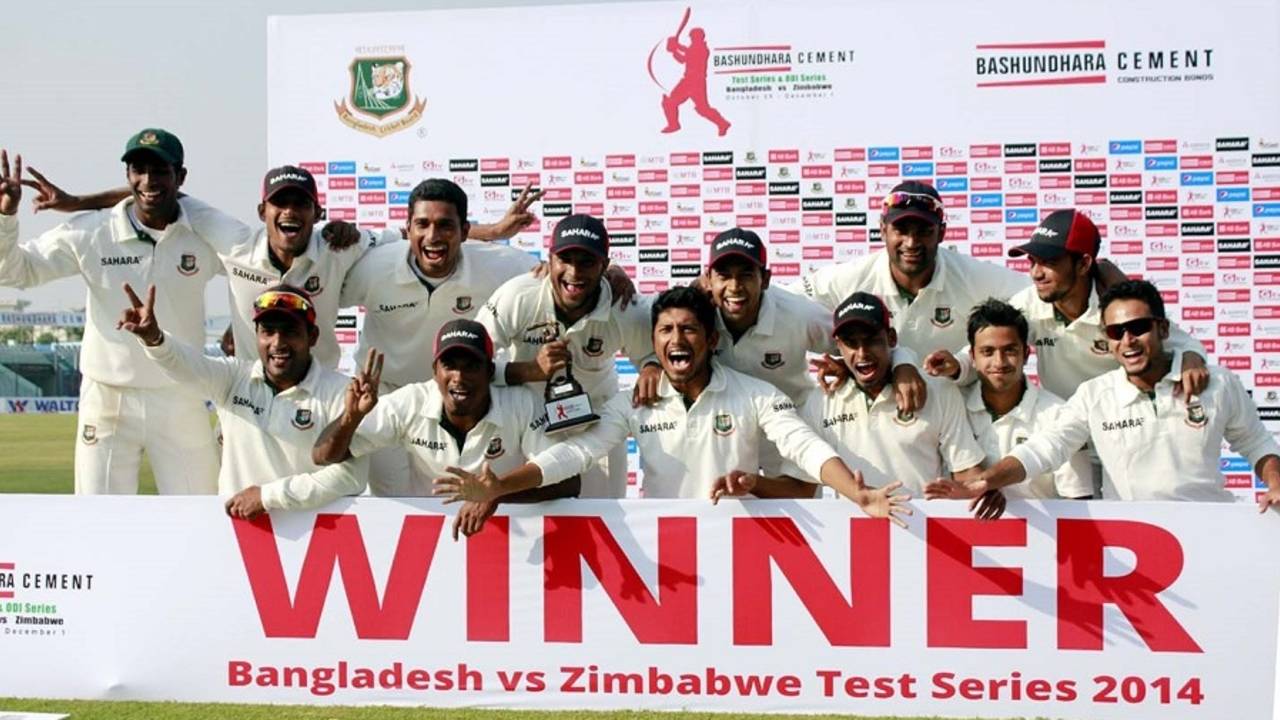The resurgence Bangladesh waited a year for
Bangladesh's 8-0 victory over Zimbabwe in the Tests and ODIs represents a general sense of relief and a restoration of a cricket-mad public's trust in the team
Mohammad Isam
02-Dec-2014
Bangladesh have had much to celebrate in the last six weeks • BCB
There are several ways to measure Bangladesh's success in the Test and ODI series against Zimbabwe over the past six weeks. The 8-0 winning streak represents a general sense of relief and a restoration of a cricket-mad public's trust in the team.
They had lost 22 of 27 matches across formats till mid-September, and had come back devastated from the tour of West Indies. The team was sore from losing everywhere and to every kind of opponent. The captaincy was split and one of their more dependable batsmen was dropped. But their best player returned and all the eggs were put in the Zimbabwe basket.
There was an all too familiar hiccup on the third day of the Dhaka Test, but Mushfiqur Rahim and Taijul Islam manoeuvred Bangladesh to victory and Zimbabwe were broken. There have been periods when a Hamilton Masakadza, or a Sikandar Raza or a Tinashe Panyangara resisted but it never lasted too long. Zimbabwe were confused by spin and they struggled against pace in the ODI series as well. Bangladesh's catching and fielding was largely good and most importantly, the batsmen remained consistent.
The opening pair had to be tweaked only once in the Tests. Imrul Kayes was drafted in for the out-of-form Shamsur Rahman and became party to Bangladesh's highest first-wicket partnership. Tamim Iqbal had been at the other end during the 224-run stand in Chittagong, and his patience and hunger to bat out the entire day's play in Khulna was of great benefit to Bangladesh.
A slightly patchier Tamim was part of two superb starts in the ODI series as well. His partner Anamul Haque must address his limited footwork but has showed a desire to bat long, which bodes well for a line-up that craves stability.
Shakib Al Hasan reiterated why he is Bangladesh's heart and soul. He became only the third cricketer after Ian Botham and Imran Khan to take a ten-for and score a century in the same Test, in Khulna. In the ODI series too, he scored his sixth hundred and took a four-for in the same game.
Mominul's consistency rose to a new peak during the Tests. He topped Bangladesh's charts with 321 runs and has 11 fifty-plus scores from 12 Tests, following in the footsteps of Everton Weekes, Sunil Gavaskar and Mark Taylor. He was nondescript in the ODIs though, where he was shunted around the batting order and "rested" for the last two games.
Mahmudullah has looked like the Mahmudullah of old, using his wrists and getting Bangladesh out of trouble. Shuvagata Hom has struggled and Sabbir Rahman has not yet cemented a spot in the team, which means that Nasir Hossain, who did not feature even once in this series, could still make a comeback in the World Cup.
Taijul hurtled to the top of a crowd of left-arm spinners in Bangladesh with 8 for 39 in Dhaka, the best figures by a Bangladeshi in Tests and a hat-trick on ODI debut, and Jubair Hossain has shown a lot of promise as well. Taijul was a revelation in how he flighted the ball and ensured the batsmen played him regularly. He doesn't change his line too often, but has the knack of slipping in the arm ball to catch batsmen on the crease. Jubair became the first specialist legspinner to play Test for Bangladesh, and celebrated with a five-wicket haul in Chittagong. He was effective in the ODIs too, but Jubair, his team-mates and the fans still have a long way to go in understanding legspin bowling.
They were helped by Shakib's attacking mindset at the other end. He demanded good footwork from batsmen but Zimbabwe were lazy at times and genuinely flummoxed by the best cricketer ever produced by Bangladesh.
And lastly, the most under-appreciated group of cricketers in Bangladesh: the pace bowlers. Shahadat Hossain was the sole seamer for the first two Tests before Shafiul Islam took the lead in Chittagong and hurried batsmen on a pitch that offered him nothing. In the ODIs, Mashrafe Mortaza has been on the mark and took the first wicket in three of the five ODIs. Rubel Hossain bowled better in the shorter format while Abul Hasan looked like a bowler coming back after nearly two years of injury.
All these elements put together the 3-0 and the 5-0 victories. Realistically though, it should not have much bearing in the lead-up to the World Cup. It was just Zimbabwe, critics would say. But it should be noted that the visitors arrived as the higher-ranked Test side.
Confidence will be high among the Bangladesh ranks from this point. Split captaincy is new to Bangladesh and Mashrafe has led the ODI side astutely, while Mushfiqur helmed Bangladesh's first 3-0 whitewash in Tests and would hope to take the positives to April 2015 when they meet Pakistan.
Now it is time to reflect on what was good and what worked. Complacency should not be given an inch from December 2, otherwise Bangladesh will always be judged as No 9, not as a potential No 7.
Mohammad Isam is ESPNcricinfo's Bangladesh correspondent. @isam84
